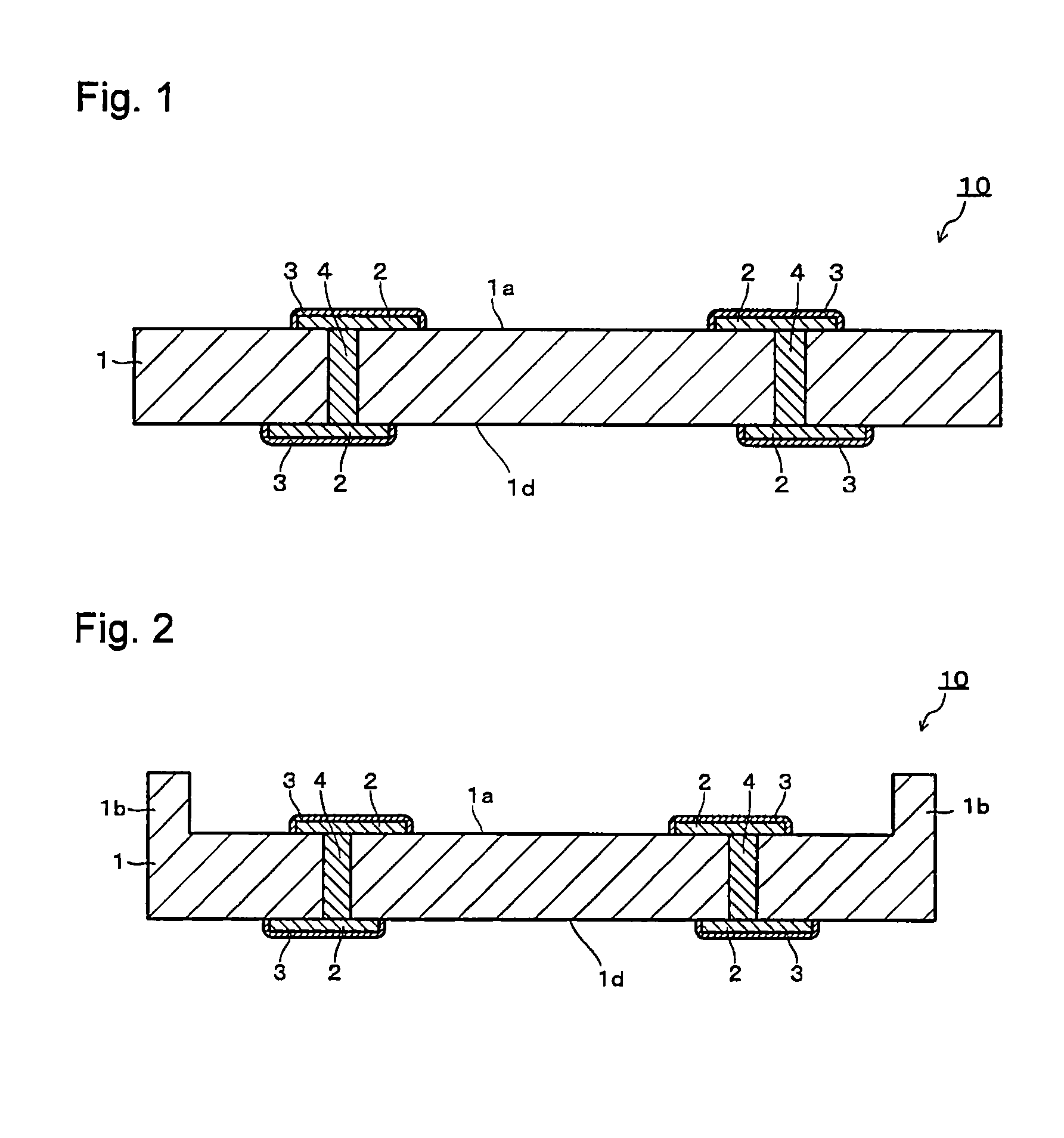Substrate for mounting element and process for its production
a technology of mounting elements and substrates, applied in the direction of manufacturing tools, conductive pattern formation, semiconductor/solid-state device details, etc., can solve the problems of deterioration of resin substrates, substantial increase in production costs, and failure to pass sulfurization tests, etc., to achieve excellent sulfurization resistance and good plating properties
- Summary
- Abstract
- Description
- Claims
- Application Information
AI Technical Summary
Benefits of technology
Problems solved by technology
Method used
Image
Examples
example 1
[0063]A substrate 10 for mounting element having a construction as shown in FIG. 1, provided with a LTCC substrate, was prepared.
[0064]Firstly, a glass ceramics green sheet for main body to prepare the substrate 10 for mounting element, was prepared. In the preparation, raw materials were blended and mixed so that SiO2 became 60.4 mol %, B2O3 15.6 mol %, Al2O3 6 mol %, CaO 15 mol %, K2O 1 mol % and Na2O 2 mol %, and this raw material mixture was put into a platinum crucible and melted at 1,600° C. for 60 minutes. Then, this molten state glass was cast and cooled. This glass was ground by a ball mill made of alumina for 40 hours to obtain a glass powder for substrate main body. Here, ethyl alcohol was used as the solvent at the time of grinding.
[0065]40 mass % of this glass powder for main body and 60 mass % of an alumina powder (tradename: AL-45H manufactured by Showa Denko K.K.) were blended and mixed to prepare a glass ceramics composition. To 50 g of this glass ceramics compositi...
example 2
[0073]A substrate 10 for mounting element having a construction as shown in FIG. 1, provided with a ceramics substrate, is prepared.
[0074]Firstly, a ceramics green sheet for main body to prepare the substrate 10 for mounting element, is prepared. In the preparation, firstly, 96 mass % of an alumina powder (tradename: AL-45H manufactured by Showa Denko K.K.) and 4 mass % of a sintering aid (a talc powder containing 65.8 mass % of SiO2 and 34.2 mass % of MgO) were blended and mixed to prepare a ceramics composition. To 50 g of this ceramics composition, 15 g of an organic solvent (a mixture of toluene, xylene, 2-propanol and 2-butanol in a mass ratio of 4:2:2:1), 2.5 g of a plasticizer (di-2-ethylhexyl phthalate), 5 g of polyvinyl butyral (tradename: PVK#3000K manufactured by DENKI KAGAKU KOGYO KABUSHIKI KAISHA) as a binder and a dispersing agent (tradename: BYK180 manufactured by BYK Japan KK)) are blended and mixed to prepare a slurry.
[0075]This slurry is applied on a PET film by a ...
PUM
| Property | Measurement | Unit |
|---|---|---|
| surface roughness Ra | aaaaa | aaaaa |
| particle size | aaaaa | aaaaa |
| temperature | aaaaa | aaaaa |
Abstract
Description
Claims
Application Information
 Login to View More
Login to View More - R&D Engineer
- R&D Manager
- IP Professional
- Industry Leading Data Capabilities
- Powerful AI technology
- Patent DNA Extraction
Browse by: Latest US Patents, China's latest patents, Technical Efficacy Thesaurus, Application Domain, Technology Topic, Popular Technical Reports.
© 2024 PatSnap. All rights reserved.Legal|Privacy policy|Modern Slavery Act Transparency Statement|Sitemap|About US| Contact US: help@patsnap.com










